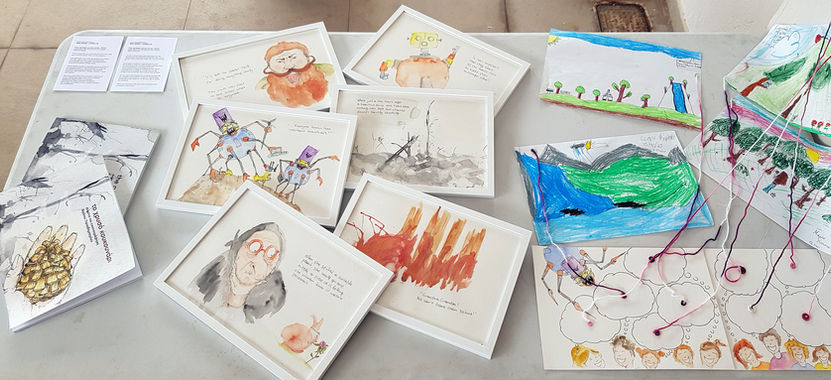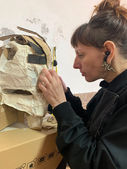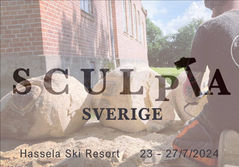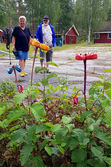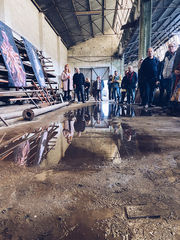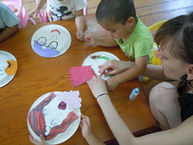
Local artists Lab, Turning the Tide Evia international Lab art residency, co-funded by the European Union through Creative Europe. Evia, Greece 2025
Partners: Intercult (Sweden), Artit (Greece), Instytut Kultury Miejskiej (Poland, Wiener Bildungsakademie (Austira), Dear Hunter (Netherlands)
Participating artist: Eleni Vrettakou, Jo Hodges & Robbie Coleman, Zoe Franzen Lakides, Johanna Tinzl, Omeeros, Angela Liosi, Maria Gouveli, Dear Hunter, Froso Papadimitriou
In collaboration with: Fablevision (Scotland), River//Cities Network (Austria)
Community engagement residency on the theme of natural disasters and climate change.
For this residency I worked with the residents of the villages of Kourkoulous, Skepasti and Kechries in north Evia recording their stories, thoughts and worries in relation to the repeated nature disasters that devastated the area.
My aim here was to create a useful tool for the community to explain and inform the young people and children about the events that took place in the area, what that meant to the communities there and what does that mean about their future. The worked aimed to open a dialogue with parents and children about the different facets of climate change, such as political, economical and social.
My final work was a 50 page hand-drawn fairy tail based on the stories and testimonies collected from the locals and it included a foldout with the drawings of the young kids:
Niki (Kourkouli), Eleni (Skepasti), Andriana (Skepasti), Andromachi (Kehries), Eleni (Kechries), Christos (Kechries), Konstantina (Kourkouli), Nikos (Kechries), Mariadni (Kourkouli), Giorgos (Kehries), Angeliki (Kourkouli), Eleni (Kourkouli), Giannis (Kechries), Iliana (Kourkoulous), Maria (Kechries), Nektarios (Kehries), and Nikos (Skepasti).
The golden pine cone
book
water colour, fine line pigment ink on paper
50 pages hand illustrated book based on the true story and testimonies of the devastating disasters in Northern Evia between 2021 – 2023
“Many voices that are still unheard, and a story that has so much to teach, that can’t be forgotten.”
During my time with the people of Northern Evia, I came across a powerful story that encompasses the complexity and multifaceted character of climate change today.
While climate change is typically framed in terms of atmospheric shifts or natural disasters, it also has an underlying intrinsic economic and political character, especially how “climate change” is used and applied.
The story of northern Evia unravels a timeline of events displaying a stark view of how political negligence, opportunistic economics, administrative failure and lack of climate knowledge converged to turn a natural disaster into devastation.
I constructed a fairy tale based on the testimonies I collected during my visit, not to escape from reality but rather as a way to reframe it. Knowledge manifests in different forms, and through time it has travelled furthest with parables, stories and folklore, encoding moral and environmental insight in symbolic forms. This is especially true of children, as tales become the bridge to the world they inherit from their parents.
We use tales and metaphors to simplify and describe the complex environments we live in, and by being positioned as the audience, we become able to reflect on ourselves.
There is a story here that asks more questions than it answers.
Quimera art residency, Aldeia de Ana de Aviz Figueiro dos Vinhos, Centro Convivio, Portugal. 2025
Organised by Paulo Robalo II and Luis Robalo.
Participating artists: Paulo Robalo II, A+B Beatrice Peter and Albert van Loon, Tatum Kempers and Rick Kup, Susana Gorjão, Romeu Delmar, Jorge Branco. Froso Papadimitriou
Community engagement residency with the aim to bridge the two communities of the area, that of the locals with the new foreign residents of the area and create the first permanent modern art collection of the council of Figueiro dos Vinhos
For this work, I asked residents of Aldeia de Aviz to unravel, measure and cut a tread and hand-write their names on a piece of paper. In my work each thread represents a life, in accordance to the Greek myth of the three fates, the thread of life is unravelled, measured and cut for each person.
I attached the handwritten name of each participant to their chosen thread and by interweaving these threads together, whilst maintaining the name tags on them, I create a metaphorical representation of the birth of a new future. The art installation consisted of a broken classical sculpture head, resting on a rusting wood piece with a small castle like structure on it and from the holes in the head a bright colourful flower grew.
The head was made of cardboard and masking tape – to highlight the ephemeral nature of empires. The rust on the wood was a comment on the alteration and appropriation of the nature around us and its consequences and the flower was made with the threads measured and cut by the people of the community.
The aim of this work was to create a platform for discussion about where the craving of ego projection lead humanity and a future where, whilst maintaining your won identity and importance, as whole work together for a more sustainable and balanced future.
Escape
art installation
cardboard, masking tape, wood, iron oxide, threads, tree barks, paper
“One thread simply exists, where many create clusters and form societies.
Throughout our history and from these clusters, empires have risen and fallen, having one thing in common, among others. The endless ego-driven hunger for power. It has been the “I” that has built our world, yet it is the “I” that is also destroying it.
The god-like power of reshaping our human and natural environments to fit one’s utopia is now costing us our humanity.
I am searching within this vicious circle for a way out. A regeneration, a breath of new life where we together create our future, yet without losing sight of who we are.
New life arising from the ruins of old ideals.
Nature adorned with handwritten names – identities of you and I – reminding us that who we are is an integral component in the attempt to reshape the future, not for the one but for both nature and humans alike."
Sculpta - Sverige art residency, Hassela ski resort, Sweden
Organised by Sculpta - Sverige collective
Participating artists: Paulo Robalo II, Tatum Kempers and Rick Kup, Zep Pietersen, Theo Flong, Adam Bradley, Lars Ingar Lundin, Froso Papadimitriou
Art residency for the 2nd Sculpta - Sverige art festival in the town of Hassela, Sweden.
No connection
site specific installation
found telephone cables, dead bark, fabric, thread
Human intervention has been our survival. The ability to alter and utilize nature around us to persevere, grow and expand has always been our driving force. The cycle of appropriation, use, discard, and then reclaimed by nature has been activated since human appearance on the planet. But what is the cost and how permanent are the effects of this terraforming, one should wonder.
We work the nature but do we connect with it through our inventions and progress? And what is the significance of connecting with nature in the first place?
Our highest achievement is a majestic network, crossing borders, and bringing the world closer. Time and distance have no relevance now, we exist in a universal transmission unlimited to its capabilities. Resembling the Mycorrhizal network of the plants we use our networks to exchange information, news, beliefs, theories and threats.
But with a significant difference. The Mycorrhizal network’s purpose is to promote the well-being and survival of all organisms attached to it, through this exchange of information. It is a network of connectivity for different species to cohabit and benefit from this cohabitation.
Does our own network aim the same or it has become a tool of polarization, division and isolation?
With questionable intentions we load this network with information that serves the singular rather than the whole, trying to create independent clusters within the same environment and while the sole idea of a network is to connect we use it to divide and disseminate our cohabitation. We pride ourselves on our interconnection yet we lack the human interaction. There is a firm determination to create our own new environments but at its core we lack the knowledge, we ignore existing successful models and use tools and foundations that serve only the individual.
It might look like a flower but it feels and smells like plastic.
Utopia, art residency, Campo Mineiro Fundao Panasquiera mine, Fundao, Portugal
Organised by Penumbra Collective and Ar.s Fundão
Participating artists: Paulo Robalo II, Joao Didelet, Tatum Kempers and Rick Kup, A+B Beatrice Peter and Albert van Loon, Alexandre Almeida, Christina Costa, Diogo Lidonio, Gil Gelpi, Iris Poljan, Joao Barbosa, Luis Robalio, Madalena Bettencourt, Maria Barroco, Susana Gorjao
The art residency took place in the disused mineral refineries of the mines, which the council of Fundao wanted to be reintroduced to the community as a historical and cultural heritage. The art residency and the works that remained in the space in permanent display inaugurated a long term art programming for the area, aiming to engage with the local community and reclaim these disused spaces transforming them into cultural centres.
For this residency explored the notion of the theme utopia and utilised the existing history of the place to build a work that opens a discussion on the realities of individual envisioning of a utopia for all. AA
Utopia
site specific installation
thread, found objects, door viewer
From the Heights of Despair, philosopher Cioran sees utopia as a monstrous fantasy; an ouroboros eating its tale. It is the achievement of happiness that creates an oxymoron with that of human nature. If utopia is the final stop of mankind’s journey, will the human condition be satisfied with its stillness when we reach it?
And yet we haven’t even looked at the notion of utopia “the eternal happiness” under a magnifying glass. For as utopia is the state of being amongst the perfect environment, given that to be social, ecological, spiritual and so forth; where happiness on the other hand it’s by far an individual and individualistic quest and for many, the means of achieving as such are blessed by the cause.
The sole fact that throughout our lives we are presented with more than one utopias, including our own version of it, alarmingly indicates its subversive and mischievous nature. At our core, most people believe we know how a better world would look like. Isn’t that scary and whimsical? for the simple reason of how many of us would be willing to compromise our own utopia to accommodate for others and share a vision…and let’s not even start about authorship in that eventuality.
One would argue that the finest utopia of them all would be based on ethics, respect and peaceful coexistence, unwarranted of laws or rules, aka anarchism in its core. What a beautiful vision that would have been if not for all its three components to be fundamentally idiosyncratic, empirical and given the power authoritarian. That subsequently leads to one’s utopia being another’s dystopia.
As George Orwell puts it: “Nearly all creators of Utopia have resembled the man who has a toothache, and therefore thinks happiness consists in not having a toothache…Whoever tries to imagine perfection simply reveals his own emptiness”
Resident artists at Beckenham Place Mansion Studios, London UK (2017 - 2019)
I was one of the artists selected to held a studio art residency at the Beckenham Place Mansion Studios, London from March 2017 - May 2019. During my residency I had the opportunity to hold open days and studio visits for the members of the community.
... and with the marks on my hands I will tell you my story…Hajichi - Art residency, solo exhibition and lecture at Arcade Art Studio and Space, Okinawa City, Okinawa Japan
I was invited by Osamu Miyagi from the Arcade Art Studio & Space to participate in the studios first residency. For this residency I work on the theme of national identity and relevance of history and traditions and I created a site specific installation, part of which remains as a permanent display in the studio. In addition I organised and delivered a lecture on my findings and processes which included a solo show and an artist talk. Special online guest artist Yuken Teruya. Furthermore I run a children's workshops with artist Sarah Karin Fisher at Shinkai nursery, Nanjo-shi, Okinawa, Japan
The site specific installation I created was based on a research I did about an old tradition of women hand tattooing (Hajichi), which due to the ban under the ruling of Japan, it was lost and forgotten in time. I have taken a particular interest in this tradition special interest not only due to its intriguing meaning, technique and beauty; but also due to the political and social affiliations this tradition bares. The work is looking at how this tradition has faded overtime, with very few records remaining, and how such tradition manifest it self in a contemporary society.
The installation consisted of a centre piece and the surrounding walls are covered with the symbols tattooed by the women, with each symbol having a particular meaning almost like a language. These were made by white thread, indicating something that is almost invisible but omnipresent at the same time.
Local traditions mark our identity as nations; folklore and rituals are carried in time, from tribe to tribe, from family to family, from person to person. Preserved to mark our passage through history, and have been challenged in time of conflict and through occupations, in order to dissolve national unity and strength.
In contemporary society, in our daily lives, little room is left to practice our ancestral customs, but traditions and rituals have become part of our museum attractions. Does conservation of the ‘Old Ways’ reflects their significance in our identity? Do we share the same identity with our ancestors or is the past just a mark of our existence in the passage of time?
Hajichi, a significant but now fading tradition of tattooing on the hands and arms of Okinawan women, recorded from the early years of the Ryukyu kingdom and officially banned in 1899 during the Meji era, is the subject of discussion in my residency and lecture.
How in the contemporary Okinawa, where Japanese ruling has suppressed the Okinawan tradition and American presence on the island has infiltrated the culture, Okinawans connect to their national identity which they are trying to safeguard from these influences and what role these important band tradition play in the forming of their spatial identity?
This installation is now permanently in a studio that offers art classes to young art students and has become a platform of discussion about this tradition keeping the memory of this tradition alive. At the time of my exhibition there was little talk about this tradition and in a survey I conducted the majority of youn people I asked didn't know it at all or seen the marks on their grandmothers hands but didn't know what it was - the older generation experiencing the ban and persecution of the Hajichi practice prefered not to talk about their tattoos. Since my exhibition there has been another 2 major exhibition on the subject and in the recent years has been a noticeable revival of the tradition between young women in Okinawa.















